

![[GK24 logo]](gk24logo.gif)
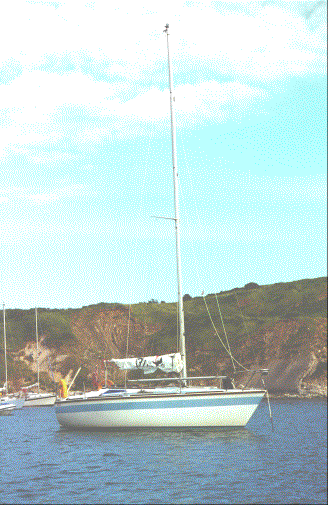


![[GK24 logo]](gk24logo.gif)

or winning the GK24 trophy for the second time, this time as ISC, rather than IRC...
Steve Sims : spinnaker and genoa trimmer
Les Starkie : helming, foredeck and genoa trimming
Duncan Hobbs : genoa trimming
Nigel Nicholson : navigation and tactics
Mike James : helming and navigation
Had invited entire crew to take part back in February and they were all able to be aboard for the race.
Used time Friday evening to quickly check and lubricate all of the winches. Also the traveller.
Wound down 3 turns on below deck on wires to pull deck down.
Bad sleep too windy halyards tapped until I went outside to look when they would stop. Boat kept rolling in the wind and rattling around. Occasional punts from the Avon added to the chaos.
Decided not to take the Avon with on the race. Big mistake later at the Folly.
got about 4 hours sleep all round
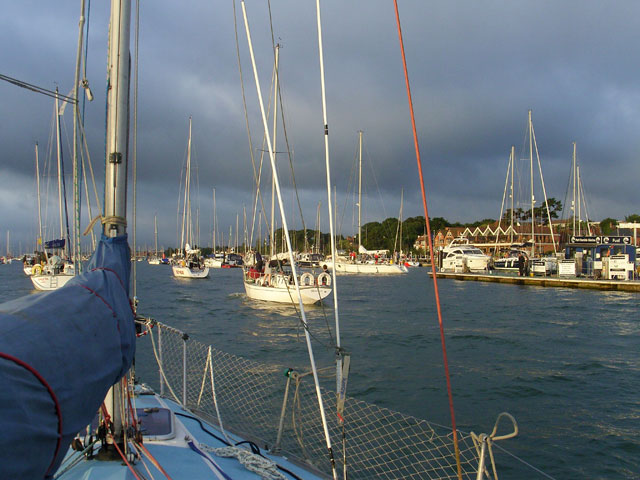
Began adjusting the the shrouds, got call from crew at 0540 so had to stop messing around and pick them up from Hamble Quay (you can see the tension gauge still on the shroud . Then had to wait until everybody found a place to park their car.
Headed out to start eating bacon rolls like usual.
Wind seemed about force three but as the fleet cleared the line we got more and more wind.
Our start was 0730:
We stayed much closer to start line than
usual. In fact one minute before start , are on course side, looking
at transit lights, but move back over a few tens of metres. When the
gun goes we were in clear air and reaching fast south. Started about
half the length of the line on Starboard.
There was a sudden burst of fog around start time but this cleared while we started.
Beating down Solent.
Once away from the start line we were in clear air because of the good start. Because we had five crew on board, one crew member kept lookout from lower down in the cockpit, around the blind spot of the genoa. Sailing weith the number 2 meant we could tack faster as there was less rope to haul in and the sail obscures less of the view forward.
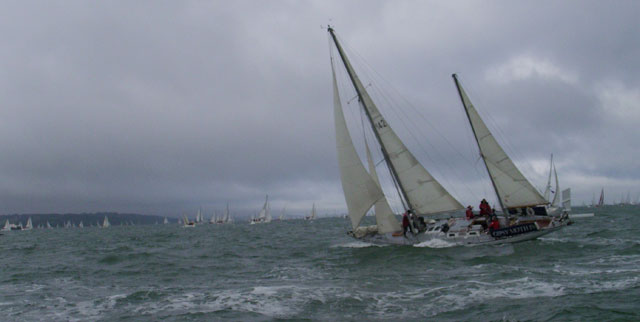
We were able to track the tide on the GPS and the fishfinder by depth of water, and sailed slightly further to the mainland side in deep water still. With the tide we were at 6.5 to 7 knots to windward. Nigel and the rest of the crew were calling out free space to tack into.
We lined up with the current off Yarmouth going for the 30 metre plus depth which leads into the fast tide through Hurst Narrows. Each time as the speed over ground dropped to the North or the wind strength started to drop to the Island side we would tack.
Hurst narrows were busy but manageable again because of the crew constantly checking . We only once were carried off optimum course by boat slightly to windward while on starboard. People were not sailing in the strongest fair tide so we had a nice clear wind.
At the Needles there were lots of boats overstanding quite badly, even if they intended to clear the wreck. Again we went inside the wreck, bearing away in a wide curve around breaking waves on Goose Rock, and looking back on the GPS track we came closer to the boiler as a result. Once in the Scratchells Bay we decided to go for the spinnaker and reach back in keeping closer inshore than much of the fleet. A small group of smaller or similar boats came through with us and we moved away from them.
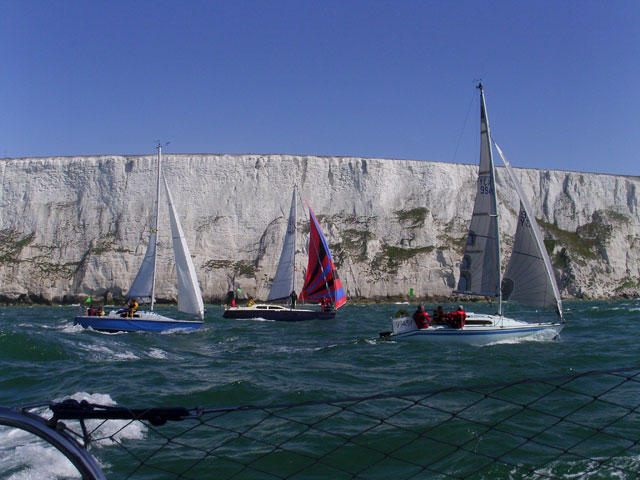
At first there just a large swell which Steve commented was rather like further west in the Channel but as the fleet spread out and the wind was less blanketed by boats offshore, things got wilder. Les helmed for a while until the boat broached for the first time. We started practising not broaching (not stalling the rudder by heaving too hard, riding down waves ) and practising recovery.
Tried to make phone calls but this caused broaches . So did crew visit to the heads. Toilet lid slammed down in a painful way while in use onto one crew's member.
From Atherfield ledges southwards could see reach becoming skinnier, the few spinnaker boats ahead could be seen to be having a hard time. We ended up with main flapping with the kicker off and the boom pointing skywards on beam reach, balancing on the edge of a broach for minutes at a time. The kicker slackening was only way to get the mainsail past the shrouds.
So we had only the 33 square metre spinnaker pulling hard.
As we passed Blackgang Chine , Shirley who was there with the children was able to see us -

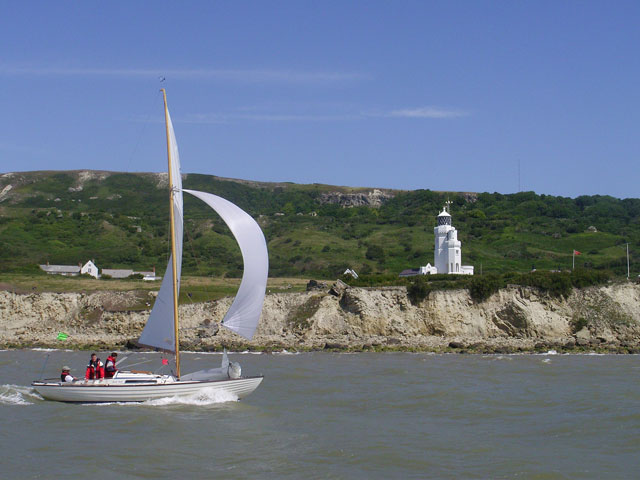
We came in fairly close to st Cats . Gybe at Dunnose messed up when traveller shot across ripping mainsheet from hand – it had become cleated in the process. I hadnt locked off the traveller.
There was no time for proper food or more than water bottles to drink
As we approached Bembridge ledge slowed deliberately to slot in behind some bigger boats.
Reach up fluky and hard to hold. Tried to put in a reef boat went very dead and slowed in lulls between overwhelming gusts Sail trim was off, probably oversheeted genoa. Returned to full main about a mile before the fort.
We cut in close to sail into lee of the fort, including being told off by the boat behind us for taking him up towards the fort. This was to avoid the mess between the forts, where boats stopped and then got pushed back by the tide, leaving a nice clear space. Then we sailed much too close to windward side of the fort and lost wind almost being pushed by the tide into the fort. Spent 30 seconds looking up at the gantry on the western side of the fort and deciding that we would probably pass clear under it. But I was aware of the stepped out base of the fort and how close we had come.
Made it back over to Ryde sands , making the putting of the fort in the way simply a nusiance – sailed effectively the same course as if it were not there with one short dive out into foul tide.
The reef went back in once around the fort and steady on port tack with no boats around us . We were seeing about 1 knot of foul tide on the GPS.
Somewhere around the fort the wind bent about 45 degrees left – probably why it was so fluky at Seaview north.
The beat back to Cowes started with the usual going too far and having to bear away for Ryde sands – it took strange behaviour of boats to windward to remind me of how far up the sands we were. Boats aground served as markers – we usually commenced a tack in 20 feet of water and went in as far as about 10 to 15 feet before turning away from the sands.
Later on we were treated to the sight of a crew member on another boat standing up to their chest in water on the sands and trying to push their boat off.
From about Ryde Pier we were able to hold a course for the finish line but this again took us too close to Castle Point and we lost wind. With a reef in the main we stopped. Just on the finish line we had a Sunsail boat (07) call starboard on us then tack on to port top of us and then bear away. When challenged to go up they shouted about needing room to tack (they had) and then that they couldnt manouver because they had a broken rudder. We then had to duck hard for another starboard tack boat, fortunately they put the Sunsail boat about and the two of them actually cleared the finish line for us to be able to put in a couple of tacks away from the side of the Island Scene and cross the line. Duncan went incandescent at the Sunsail boat's behaviour but looking back it was not too much of a problem – we would have had more difficulty finding space to tack and finish if they had not blundered in. I swore at them for a bit and then got over it and on with the remaining minute or so of the race.
As we crossed, Cathy Smalley on the committee boat recognised us and called out to us. A nice way to finish.
Arrived at the Folly and owing to a comms breakdown find after we had moored that Nigel with motorboat was up at Island Harbour, not at the Folly as prearranged. So we tidied up, said goodbye to Nigel Nicholson and Les Starkie who had to go back to Southampton, and got down to drinks with Nigel-the-motorboat on his boat.
Duncan phoned a friend who
told us that we were the first placed GK24 by a large margin.
We had several tinnies and crisps before staggering up to the Folly for an evening meal and drunken discussion with other crews.
Next morning sat in agony waiting for the first Folly water taxi of the day to get on with the showers etc. Should have gone to Island Harbour or taken the Avon dinghy over with us.
Duncan was in a bad way and managed to fall asleep in the shower while towelling off afterwards, opening the door 20 minutes later to a rather annoyed queue. He then fell asleep on one of the Folly tables.
Duncan, Steve and myself walked from the Folly into Cowes, as this is one means of getting over the night before, visited the Island Sailing Club and signed for and collected the cup - it is not presented in the marquee
| Year | Time |
| 1997 | |
| 1998 | Won GK24 cup |
| 1999 | |
| 2001 | 09:05:02 |
| 2002 | missed |
| 2003 | 09:43:18 |
| 2004 | 08:30:04 |
| 2005 | 11:11:28 |
| 2006 | Retired at Hurst |
| 2007 | 09:29:45 |
| 2008 | 08:37:09 |
Average Speed: 5.4 kt
Maximum Speed: 8.5 kt at 13:04:30 BST in Sandown Bay
Minimum Speed: 0.1 kt
Breakages
Nothing , except the topping lift pulley block at the mast head has disintegrated or seized.